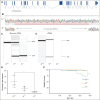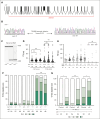Loss of factor VIII in zebrafish rebalances antithrombin deficiency but has a limited bleeding diathesis
- PMID: 40085950
- PMCID: PMC12242437
- DOI: 10.1182/bloodadvances.2024013143
Loss of factor VIII in zebrafish rebalances antithrombin deficiency but has a limited bleeding diathesis
Abstract
Deficiencies in coagulation factor VIII (FVIII, F8) result in the bleeding disorder hemophilia A. An emerging novel therapeutic strategy for bleeding disorders is to enhance hemostasis by limiting natural anticoagulants, such as antithrombin (AT3). To study pro/anticoagulant hemostatic balance in an in vivo model, we used genome editing to create null alleles for f8 and von Willebrand factor (vwf) in zebrafish, a model organism with a high degree of homology to the mammalian hemostatic system and unique attributes, including external development and optical transparency. f8 homozygous mutant larvae surprisingly formed normal thrombi when subjected to laser-mediated endothelial injury, had no overt signs of hemorrhage, although they did have a modest increase in mortality. We have previously shown that at3-/- larvae develop disseminated intravascular coagulation (DIC), with spontaneous thrombosis and fibrinogen consumption, resulting in a bleeding phenotype marked by secondary lack of induced thrombus formation upon endothelial injury. We found that with loss of FVIII (f8-/-;at3-/-), larvae no longer developed spontaneous fibrin thrombi and produced clots in response to endothelial injury. In contrast, homozygous loss of zebrafish Vwf failed to rescue the at3 DIC phenotype. These findings demonstrate an altered balance of natural anticoagulants that mitigates FVIII deficiency in zebrafish, similar to hemostatic drugs in the clinical development pipeline, and suggest that zebrafish FVIII might circulate independently of Vwf. Further exploration of this unique balance in zebrafish could provide novel insights into the treatment of hemophilia A and von Willebrand disease.
© 2025 American Society of Hematology. Published by Elsevier Inc. Licensed under Creative Commons Attribution-NonCommercial-NoDerivatives 4.0 International (CC BY-NC-ND 4.0), permitting only noncommercial, nonderivative use with attribution. All other rights reserved.
Conflict of interest statement
Conflict-of-interest disclosure: J.A.S. has been a consultant for Sanofi, Takeda, Genentech, CSL Behring, Novo Nordisk, Pfizer, and Medexus. B.J.S.-J. has been a consultant for Genentech, BioMarin, and Pfizer, and has research support from Novo Nordisk. The remaining authors declare no competing financial interests.
Figures








Update of
-
Loss of factor VIII in zebrafish rebalances antithrombin deficiency but has a limited bleeding diathesis.bioRxiv [Preprint]. 2024 Mar 3:2024.02.28.582609. doi: 10.1101/2024.02.28.582609. bioRxiv. 2024. Update in: Blood Adv. 2025 Jul 8;9(13):3136-3148. doi: 10.1182/bloodadvances.2024013143. PMID: 39896458 Free PMC article. Updated. Preprint.
References
-
- Shavit JA, Ginsburg D. In: Emery and Rimoin's Principles and Practice of Medical Genetics. Rimoin DL, Pyeritz RE, Korf BR, editors. Elsevier Science; 2013. Hemophilias and other disorders of hemostasis; pp. 1–33.
-
- Mannucci PM, Tuddenham EG. The hemophilias--from royal genes to gene therapy. N Engl J Med. 2001;344(23):1773–1779. - PubMed
-
- Soucie JM, Cianfrini C, Janco RL, et al. Joint range-of-motion limitations among young males with hemophilia: prevalence and risk factors. Blood. 2004;103(7):2467–2473. - PubMed
MeSH terms
Substances
Grants and funding
LinkOut - more resources
Full Text Sources
Medical
Molecular Biology Databases
Miscellaneous

